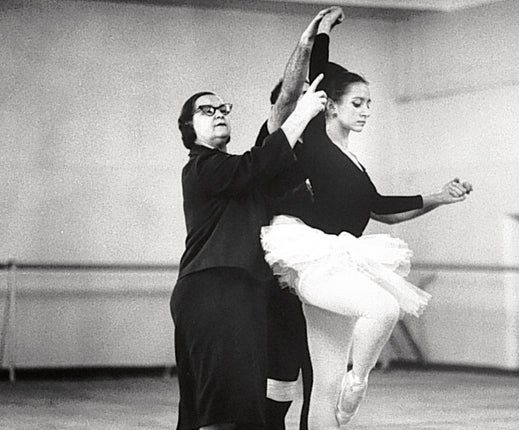Marina Semyonova: Dancer who dominated Soviet ballet in the 1930s and became an inspirational teacher

Your support helps us to tell the story
From reproductive rights to climate change to Big Tech, The Independent is on the ground when the story is developing. Whether it's investigating the financials of Elon Musk's pro-Trump PAC or producing our latest documentary, 'The A Word', which shines a light on the American women fighting for reproductive rights, we know how important it is to parse out the facts from the messaging.
At such a critical moment in US history, we need reporters on the ground. Your donation allows us to keep sending journalists to speak to both sides of the story.
The Independent is trusted by Americans across the entire political spectrum. And unlike many other quality news outlets, we choose not to lock Americans out of our reporting and analysis with paywalls. We believe quality journalism should be available to everyone, paid for by those who can afford it.
Your support makes all the difference.Marina Semyonova was a virtuoso ballerina of great warmth and clarity; majestically graceful, she was able to colour her movement with a rare harmony of strength and lyricism. Unlike the ballerinas of her time she was tall, which gave her an authority and a breadth of line and dramatic beauty. She was the pride and joy of Soviet ballet during the 1930s.
Marina Timofeyevna Semyonova was born in St Petersburg on 12 June 1908. From first to last she was the pupil of Agrippina Vaganova and graduated at the age of 17, being the first of a long string of brilliant danseuses to emerge from the Vaganova mould. At her graduation performance, she was coached by Vaganova in the part of Naila, nymph of the stream in the Petipa ballet The Brook, renamed La Source, a ballet in which her teacher had scored her initial success.
Her first appearance with the Kirov Ballet was on 11 December 1927 in Fyodor Lopukhov's The Serf Ballerina (with music by Korchmarev) which was not a success. (Later Rostislav Zakharov made a new production with music by Boris Asafiev.) Her career soon took off, however, with bravura performances in Vasily Vainonen's Flames of Paris (Asafiev), in Lopukhov's Taras Bulba (Soloviev-Sedoi) and in a host of classic ballets such as Swan Lake, Coppélia, La Bayadère, Raymonda and The Little Humpbacked Horse.
She also scored outstanding successes dancing in the operas Ruslan and Ludmilla, Ivan Susanin and Khovanshchina. She was greatly loved by Leningrad audiences and was considered to have evolved the heroic style which would become the hallmark of the Soviet Ballet of the 1920s and '30s, though the critic A Grozdev preferred to call her "the flower of the old art".
In 1930 she was transferred from Leningrad to become prima-ballerina of the Bolshoi Ballet in Moscow, where she was most regularly partnered by Alexei Yermolayev, who was also transferred from Leningrad and was one of the great heroic dancers of the era. They were well matched, Yermolayev with his soaring leaps and his demonic personality,; she with her flowing, feminine charm. Together they created a fantastic aura of magical power and epic poetry. They established the legend of Bolshoi greatness, shrouded in mystery and cut off from the world.
But in 1935, by some diplomatic sleight of hand, Semyonova was allowed abroad. Not for nothing was she married to one of Stalin's cabinet ministers! She scored one of her greatest triumphs when she danced Giselle with Serge Lifar at the Paris Opera. Needless to say, the curiosity of the public was unquenchable and her glorious élan teamed with Lifar's brilliant aplomb were a revelation that shook the artistic purlieus of Paris to its foundations. Not since Diaghilev's assault on Paris in 1911 had balletomanes been so agog with amazement and disbelief. It was undoubtedly Semyonova's greatest moment. Together with Lifar she gave a number of concert performances and was feted, after which she returned to the seclusion of the Bolshoi.
By this time a new star was rising. In nearby Leningrad, Galina Ulanova was being heralded as the great star of Soviet ballet. Semyonova's career, however, continued undisturbed until the Second World War and the evacuation of the Bolshoi Ballet to Kuibishev.
In the chaos that ensued she danced bravely on, always showing tremendous enthusiasm, no matter what she danced or what the conditions. She also did her share in taking entertainment to the troops. After the War, life could never be the same. With the return to Moscow she was gradually supplanted by the new star, Ulanova. She was no longer featured in the premieres of new ballets and her superlative assets were overshadowed by the incomparable lustre of her rival. The two great ballerinas, working in close proximity, never met. Each endeavoured to ignore the existence of the other.
By 1953 Semyonova's dancing career had run its course; she became teacher-répétiteur, a normal transition, and she proved herself an excellent, if very strict teacher, demanding from her pupils the last drop of blood. There was perhaps an undercurrent of bitterness in her character. She could be harsh; but she obtained results and from her hand came a long line of remarkable ballerinas in the aristocratic style that she extolled.
She remained head of the ballet faculty at GITIS, the Academy of Theatre Arts, and continued to coach the star ballerinas of the Bolshoi until she was 96 years old.
John Gregory
Marina Timofeyevna Semyonova, ballerina and teacher: born St Petersburg 12 June 1908; married Lev Karakhan; one daughter; died Moscow 9 June 2010.
Join our commenting forum
Join thought-provoking conversations, follow other Independent readers and see their replies
Comments